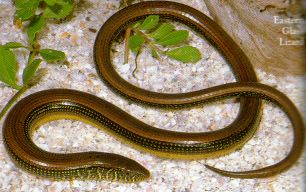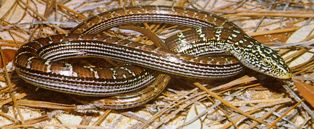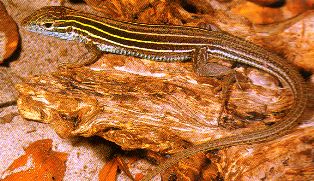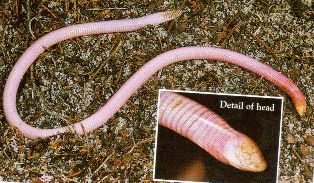Discover Florida Nature
It's time to explore the natural Florida


|
|
|
|
|
Glass lizards, or glass snakes as they are often called, a frequently
seen in Florida. Although they may appear to a form of snakes, they are
actually legless lizards. Unlike snakes, these lizards have eyelids and
external ear openings. Glass lizards are well known for their stiff
bodies and their fragile tails that break off easily when handled. The
skin of the glass lizard contains a small bone called osteoderm in each
and every scale. Glass lizards also have a line of soft flexible scales
extending lengthwise along each side of their bodies. Without this
lateral groove, glass lizards would hardly be able to move or even
expand their bodies enough to breathe. This groove is visible as a
slight fold or impression. When the tail of the glass lizards breaks
off, the regenerated tail lacks the stripes of the original tail and is
plainly colored. Glass lizards feed mainly on crickets, grasshoppers,
spiders, and other small invertebrates. In folk legend glass lizards
were called joint snakes, because people believed that they were able to
break into many pieces and then grow back together! Eastern
Glass Lizard- The eastern glass lizard is the longest and
heaviest glass lizard in Florida and is generally light brown or
yellowish to greenish in coloration. This is the most common glass
lizard in the state, and the only glass lizard that has green or blueish
coloration as an adult. Although Eastern Glass lizards may be found in
a variety of habitats they are most common in flatwoods and around
wetlands in sandy habitats. Additionally, eastern glass lizards are very
common in coastal dune habitats and are sometimes even found beneath
debris at the tide line. Eastern
Glass Lizard- The eastern glass lizard is the longest and
heaviest glass lizard in Florida and is generally light brown or
yellowish to greenish in coloration. This is the most common glass
lizard in the state, and the only glass lizard that has green or blueish
coloration as an adult. Although Eastern Glass lizards may be found in
a variety of habitats they are most common in flatwoods and around
wetlands in sandy habitats. Additionally, eastern glass lizards are very
common in coastal dune habitats and are sometimes even found beneath
debris at the tide line.
 Eastern
Slender Glass Lizard- As its name implies, the slender glass
lizard generally is slimmer than the eastern glass lizard, although both
species are generally brown or yellowish in coloration. This glass
lizard can be distinguished by the prominent dark stripe down the middle
of its back and the several stripes along its sides, both above and
below the lateral groove; although these markings may become obscured in
older individuals. This lizard seems to prefer a drier habitat than the
Eastern Glass Lizard and are common in old field and sandhill habitats.
Glass lizards forage actively by day in open habitats but are commonly
found taking refuge beneath boards and other debris. Eastern
Slender Glass Lizard- As its name implies, the slender glass
lizard generally is slimmer than the eastern glass lizard, although both
species are generally brown or yellowish in coloration. This glass
lizard can be distinguished by the prominent dark stripe down the middle
of its back and the several stripes along its sides, both above and
below the lateral groove; although these markings may become obscured in
older individuals. This lizard seems to prefer a drier habitat than the
Eastern Glass Lizard and are common in old field and sandhill habitats.
Glass lizards forage actively by day in open habitats but are commonly
found taking refuge beneath boards and other debris.  Six-lined
Racerunner- Racerunners are fond of heat and are active even on
the hottest of summer days. They are alert and active, darting between
clumps of vegetation to grab insects. During cool weather, night, or
when confronted by a predator, racerunners often take refuge in burrows.
This species is most common in hot, open areas such as fields, woodland
edges, and sand dunes and is almost always found on the ground. The
racerunner moves fast and is difficult to catch, but if pursued it
eventually tires. Six-lined racerunner hatchlings have bright blue
tails. Racerunners have more stripes overall than any other Florida
lizard and its tail is very long, making it easy to identify. Also
called the Whiptail, the Six-lined Racerunner males have an intense blue
coloration underneath the head and throat. Six-lined
Racerunner- Racerunners are fond of heat and are active even on
the hottest of summer days. They are alert and active, darting between
clumps of vegetation to grab insects. During cool weather, night, or
when confronted by a predator, racerunners often take refuge in burrows.
This species is most common in hot, open areas such as fields, woodland
edges, and sand dunes and is almost always found on the ground. The
racerunner moves fast and is difficult to catch, but if pursued it
eventually tires. Six-lined racerunner hatchlings have bright blue
tails. Racerunners have more stripes overall than any other Florida
lizard and its tail is very long, making it easy to identify. Also
called the Whiptail, the Six-lined Racerunner males have an intense blue
coloration underneath the head and throat. Island
Glass Lizard- Island glass lizards are found on dunes along the
coasts and inland in sandy areas. Fairly common in the eastern
Everglades, the island glass lizard is the least frequently seen of all
the glass lizards in Florida. As its name implies, this species is
often found on offshore islands. Sometimes Island Glass Lizards are
found under tidal debris on Florida beaches. This glass lizards body is
usually light tan with one dark stripe down each side above the body
groove, and there is often a faint stripe down the center of its back.
The island glass lizard has more mottling than the other Florida glass
lizards, but its single most distinguishing feature is the single,
broad, chocolate brown stripe on each side. Island
Glass Lizard- Island glass lizards are found on dunes along the
coasts and inland in sandy areas. Fairly common in the eastern
Everglades, the island glass lizard is the least frequently seen of all
the glass lizards in Florida. As its name implies, this species is
often found on offshore islands. Sometimes Island Glass Lizards are
found under tidal debris on Florida beaches. This glass lizards body is
usually light tan with one dark stripe down each side above the body
groove, and there is often a faint stripe down the center of its back.
The island glass lizard has more mottling than the other Florida glass
lizards, but its single most distinguishing feature is the single,
broad, chocolate brown stripe on each side. Florida
Worm Lizard- The worm lizard is a weird looking whitish-pink
amphisbaena that is neither a snake nor a lizard. The only species found
in the United States is the Florida worm lizard, which can be found in
both North and Central Florida. Except for their size, they are very
similar in appearance to earthworms, with cylindrical bodies ringed by
shallow grooves. Their eyes and ears are covered by skin. Most worm
lizards are about a foot long. Members of many species remain
underground most of their lives, feeding on earthworms, spiders, and
insects. Worm lizards are found in sandy upland areas and can sometimes
be seen after heavy rains have saturated the ground. They are sometimes
turned up during soil cultivation. The most active period for the
Florida worm lizard is early fall, a time which they may be seen on the
surface. Florida
Worm Lizard- The worm lizard is a weird looking whitish-pink
amphisbaena that is neither a snake nor a lizard. The only species found
in the United States is the Florida worm lizard, which can be found in
both North and Central Florida. Except for their size, they are very
similar in appearance to earthworms, with cylindrical bodies ringed by
shallow grooves. Their eyes and ears are covered by skin. Most worm
lizards are about a foot long. Members of many species remain
underground most of their lives, feeding on earthworms, spiders, and
insects. Worm lizards are found in sandy upland areas and can sometimes
be seen after heavy rains have saturated the ground. They are sometimes
turned up during soil cultivation. The most active period for the
Florida worm lizard is early fall, a time which they may be seen on the
surface. |
|
|
Advertise | Privacy Statement | Dog Encyclopedia | Video |Contact | Alaska Nature |
|